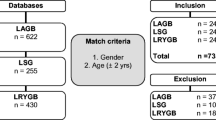Abstract
Purpose
The number of laparoscopic adjustable gastric banding (LAGB) removal has increased throughout the years. The aim of the study was to evaluate the outcomes in patients undergoing LAGB removal with or without further bariatric surgery.
Materials and Methods
Data prospectively collected from consecutive patients undergoing LAGB removal from 2008 to 2016 at our institution were retrospectively analyzed. Obesity-related comorbidities, complications, and body mass index (BMI) before removal and at 1-year follow-up were evaluated.
Results
A total of 156 patients were included in the study. Seventy-six patients had further surgery (SURG group): 55 underwent laparoscopic sleeve gastrectomy (LSG) and 21 laparoscopic Roux-en-Y gastric bypass (LRYGB). Eighty patients underwent only LAGB removal (No-SURG group). The mean BMI was lower in the No-SURG group (33.9 vs 36.3 kg/m2, p = 0.0055). Reasons for removal were different in the two groups: dysphagia, frequent vomiting, and LAGB-related complications requiring urgent treatment occurred more commonly in the No-SURG group (p < 0.05): 71.3 vs 51.3%, 67.5% vs. 38.2%, 28.8% vs. 6.6%, respectively. At 1-year follow-up, 96.3% of No-SURG patients regained weight after LAGB removal; two (2.5%) patients showed new-onset comorbidities, four (5%) needed adjustments in pharmacological therapy, and four (5%) complained from persistence of GERD symptoms. Additional surgery provided significant weight loss: the mean %TWL was 23.7% after LSGs and 27.2% after LRYGBs.
Conclusions
LAGB is associated with a high rate of reoperation. Further bariatric surgery after LAGB removal should be considered due to weight regain, persistence of GERD symptoms, and new-onset comorbidities.

Similar content being viewed by others
References
Sjöström L. Bariatric surgery and reduction in morbidity and mortality: experiences from the SOS study. Int J Obes. 2008;32:S93–7.
Buchwald H, Oien DM. Metabolic/bariatric surgery worldwide 2008. Obes Surg. 2009;19:1605–11.
Favretti F, Segato G, Ashton D, et al. Laparoscopic adjustable gastric banding in 1,791 consecutive obese patients: 12-year results. Obes Surg. 2007;17(2):168–75.
Morino M, Toppino M, Garrone C. Disappointing long-term results of laparoscopic adjustable silicone gastric banding. Br J Surg. 1997;84(6):868–9.
Suter M, Calmes JM, Paroz A, et al. A 10-year experience with laparoscopic gastric banding for morbid obesity: high long-term complication and failure rates. Obes Surg. 2006;16(7):829–35.
Naef M, Mouton WG, Naef U, et al. Graft survival and complications after laparoscopic gastric banding for morbid obesity-lessons learned from a 12-year experience. Obes Surg. 2010;20(9):1206–14.
Magouliotis DE, Tasiopoulou VS, Svokos AA. Roux-En-Y gastric bypass versus sleeve gastrectomy as revisional procedure after adjustable gastric band: a systematic review and meta-analysis. Obes Surg. 2017;27(5):1365–73.
Aarts EO, Dogan K, Koehestanie P, et al. What happens after gastric band removal without additional bariatric surgery? Surg Obes Relat Dis. 2014;10(6):1092–6.
Kindel T, Martin E, Hungness E, et al. High failure rate of the laparoscopic-adjustable gastric band as a primary bariatric procedure. Surg Obes Relat Dis. 2014;10(6):1070–5.
Mann JP, Jakes AD, Hayden JD, et al. Systematic review of definitions of failure in Revisional bariatric surgery. Obes Surg. 2015;25(3):571–4.
Biertho L, Steffen R, Branson R, et al. Management of failed adjustable gastric banding. Surgery. 2005;137(1):33–41.
Lanthaler M, Strasser S, Aigner F, et al. Weight loss and quality of life after gastric band removal or deflation; 2009. p. 1401–8.
Kirshtein B, Kirshtein A, Perry Z, et al. Laparoscopic adjustable gastric band removal and outcome of subsequent revisional bariatric procedures: a retrospective review of 214 consecutive patients. Int J Surg. 2016;27:133–7.
Riele WW, Van Santvoort HC. Rebanding for slippage after gastric banding: should we do it? 2014. p. 588–93.
Patel S, Eckstein J, Acholonu E, et al. Reasons and outcomes of laparoscopic revisional surgery after laparoscopic adjustable gastric banding for morbid obesity. Surg Obes Relat Dis. 2010;6(4):391–8.
Robert M, Poncet G, Boulez J, et al. Laparoscopic gastric bypass for failure of adjustable gastric banding: a review of 85 cases. Obes Surg. Oct. 2011;21(10):1513–9.
Fournier P, Gero D, Dayer-Jankechova A, et al. Laparoscopic roux-en-Y gastric bypass for failed gastric banding: outcomes in 642 patients. Surg Obes Relat Dis. 2016;12(2):231–9.
Dalcanale L, Oliveira CPMS, Faintuch J, et al. Long-term nutritional outcome after gastric bypass. Obes Surg. Feb. 2010;20(2):181–7.
Acholonu E, Mcbean E, Court I, et al. Safety and short-term outcomes of laparoscopic sleeve gastrectomy as a Revisional approach for failed laparoscopic adjustable gastric banding in the treatment of morbid obesity; 2009. p. 1612–6.
Frezza EE, Jaramillo-de la Torre EJ, Calleja Enriquez C, et al. Laparoscopic sleeve gastrectomy after gastric banding removal: a feasibility study. Surg Innov. 2009;16(1):68–72.
Angrisani L, Vitiello A, Santonicola A, et al. Roux-en-Y gastric bypass versus sleeve gastrectomy as Revisional procedures after adjustable gastric band: 5-year outcomes. Obes Surg. 2016.
Author information
Authors and Affiliations
Corresponding author
Ethics declarations
Conflict of Interest
The authors declare that they have no conflict of interest.
Ethical Approval
For this type of study, formal consent is not required.
Informed Consent
Informed consent was obtained from all individual participants included in the study.
Rights and permissions
About this article
Cite this article
Genzone, A., Ferguglia, A., Ambrazevicius, M. et al. Destiny of Failed Adjustable Gastric Bandings: Do All the Patients Need Further Bariatric Surgery?. OBES SURG 28, 3380–3385 (2018). https://doi.org/10.1007/s11695-018-3373-y
Published:
Issue Date:
DOI: https://doi.org/10.1007/s11695-018-3373-y




